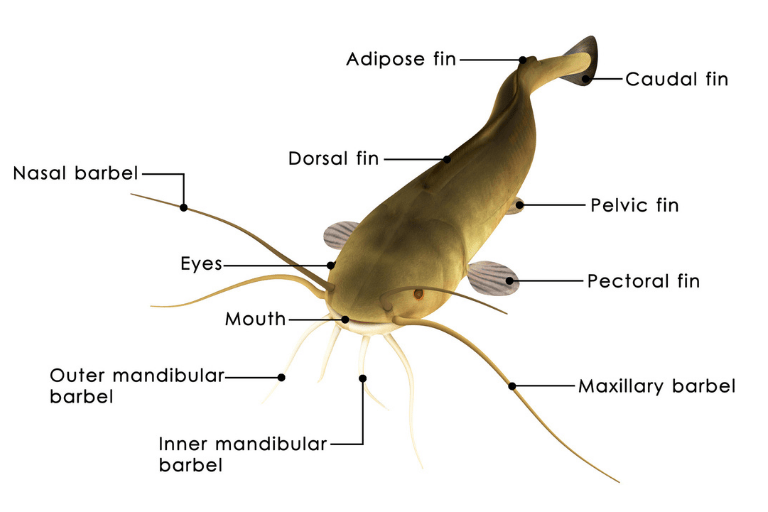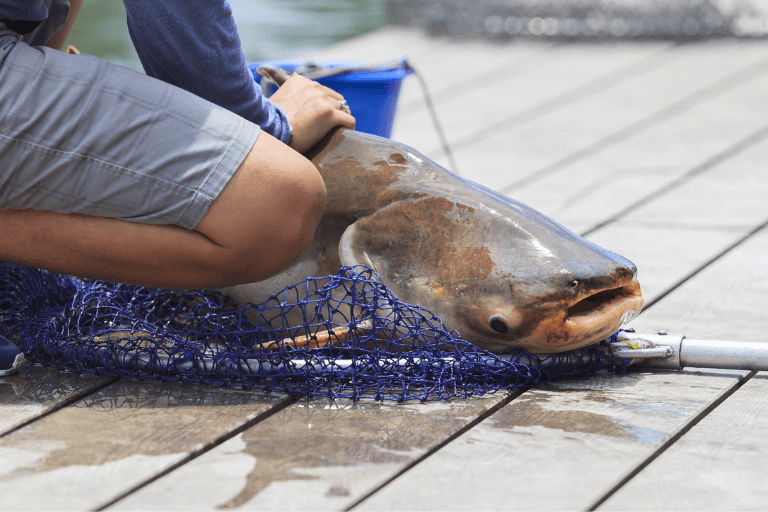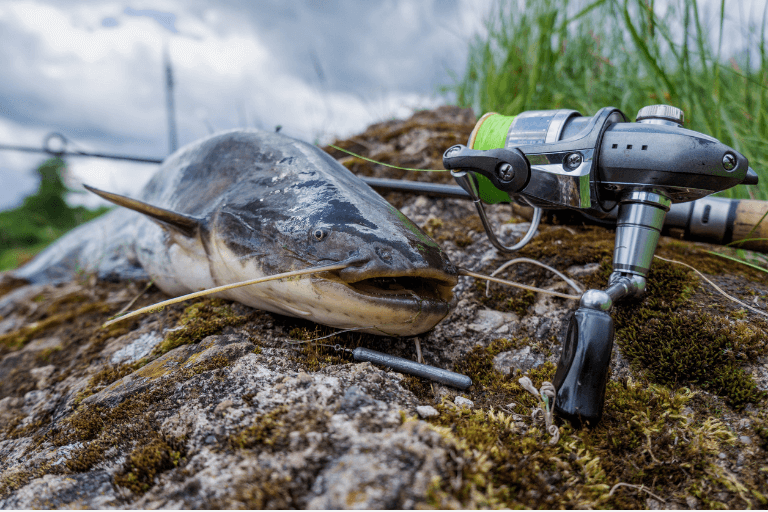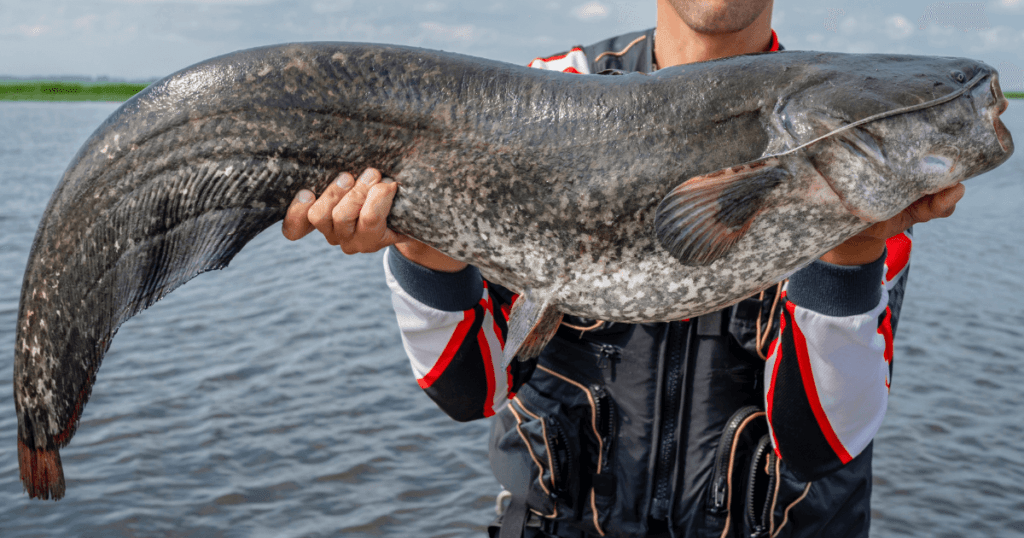Have you had some luck catching catfish during the summer but can’t seem to get one on your line the rest of the year?
Here’s some good news: It’s possible to catch catfish year-round.
Today, I’m going to cover all the tips, tricks, and know-how you’ll need to turn yourself into an expert catfish angler. So if you want to learn more about how to catch catfish then keep reading.
Catfish Basics
Catfish are hard fighting and delicious to eat. There are dozens of catfish species and you can find them on every continent except Antarctica.
In the United States, the most abundant and popular catfish targeted by anglers are:
● Blue Catfish
● Channel Catfish
● Flathead Catfish
I’m going to focus on these three popular species for the purposes of this article about how to catch catfish. So let’s take a closer look at each so you’ll know what you’re be reeling in after following our tried-and-tested catfish fishing tips.
Blue Catfish
Don’t expect to pull up an aqua blue-colored fish, because blue catfish have a blue hue mixed with a heavy dose of grey. In fact, the grey color can be so intense that you may reel in a fish that looks dark blue or even black. In either case, a blue catfish’s belly fades out to white.
It’s common for anglers to reel in blue catfish weighing 20 – 40 pounds. That’ll surely make your day, but this possibility could make your day even better: blue catfish can reach over 100 pounds!
Blue catfish commonly live in rivers ranging from Ohio to Mississippi. You may also find them in select Texas waters.
Channel Catfish
Although channel catfish have a forked tail like blue catfish, their brownish olive color gives them away as a different species. This coloring is most potent on their back and fins, with the pigment fading to white along their sides and underbelly. Younger channel catfish also often have small black spots.
Channel catfish are the smallest species of the three I’m covering here. So, if you catch one over 30 pounds, consider yourself lucky.
They’re also among the most abundant catfish species in North America. You can find them in any body of freshwater that has a low or moderate current.
Flathead Catfish
You guessed it, flathead catfish have a flat head. These fish have a mottled color pattern, including yellow, light brown, and dark brown. They also have an undershot jaw and a tail that barely has a fork.
Flathead catfish grow to massive lengths, getting as long as four feet. They’re also a popular fish in fishing tournaments since they can weigh over 100 pounds.
Lucky for you, it’s easy to find this species in nearly any corner of the United States. They tend to gravitate towards overhanging trees, undercut banks, and deep water.
Things to Know When Fishing for Catfish
If you’re serious about catching catfish, it’s important to understand how these fish operate.

The Time of Day Matters (Usually)
Most catfish fanatics will tell you that the best time of “day” to catch catfish is at night. They’re right, for the most part. But that doesn’t mean you can’t snatch a catfish during daylight hours.
Blue and channel catfish are more flexible when it comes to feedings. So, if hunger strikes and your tasty-looking bait lands in front of them, they might bite. That’s especially the case for blue catfish if you’re fishing where there is good current.
On the other hand, you’re better off fishing for flathead catfish at night. That’s the time they feel more comfortable coming out of hiding. Even so, don’t be surprised if you get a flathead on your line if you’re fishing in an area with many sunken logs and overhanging trees.
Deep Water vs. Shallow Water Fishing
One of the best ways to catch catfish is by knowing when you should fish deep vs shallow water. Catfish are not just bottom feeders. If you fish during the day, use your boat and target deeper areas. Catfish usually rest in deep water. You’ll also need to know the layout of the body of water where you’re fishing. Catfish love hanging out in nooks and crannies.
If you’re fishing at night, a boat isn’t crucial since catfish enter shallower waters to feed. It’s a win-win scenario for them, they have fewer predators at night, and they hunt using scent.
Smell and Sound
Catfish hunt using smell and sound as well as eyesight. A catfish’s entire body is covered in olfactory sensors giving them a keen sense of smell which they use to locate food. This is particularly true for channel catfish. They are arguably the easiest species to catch with bait since they love anything smelly.
Catfish also have excellent hearing created by a series of bones connecting their swim bladder to the inner ear. Plus they have a series of little pores along their sides, giving them the ability to detect low-frequency vibrations that other fish can’t. Catfish use this ability to locate nearby prey. Creatures moving across the bottom, flopping at the surface, and swimming through the water, all create low-frequency vibrations that catfish can detect.
How to Catch Catfish – Tips & Tricks
Below are some tips on how to catch catfish that’ll help you land catfish regardless of the season you choose to fish.

Best Gear for Catfish Fishing
Rods
If you’re fishing for channel catfish, a six-foot medium-power rod will suffice. If you’re aiming to catch bigger blue and flathead catfish, a seven-foot rod medium-heavy action is best. The extra length gives you more leverage when trying to land these larger catfish.
Reels
A spinning reel is all you need if you’ll be catching channel catfish. But, blue and flathead catfish need a more robust reel to handle their weight. So, a baitcaster is the best choice. Baitcasters have much a more reliable drag and are also better for shore fishing, allowing you to cast further. Read our other article Best Catfish Rod And Reel Combo to learn more about the fishing rods and reels that are best for catching catfish.
Hooks
The most common varieties are circle hooks, treble hooks, and j-style hooks. If in doubt, use a treble hook to catch catfish. A treble hook is better for holding baits such as liver or crawfish, which are two of their favorites.
You can also opt for a circle hook if you are chasing a trophy fish and want to practice catch and release. Since catfish have a strong jaw, make sure the hook is as sharp as possible to avoid a missed catch.
Bait
Even though they’re all in the catfish family, blue, flathead, and channel catfish have different tastes in bait food. Blue catfish like fresh oily fish like skipjack herring, although they’ll also consume dead, unfrozen bait.
Flathead catfish are pickier as they prefer live bait using small fish that live in their waters. You can even use smaller catfish to catch them.
Channel catfish are arguably the easiest fish to attract with bait since they love anything smelly. The more it makes you gag, the more their scavenger instincts will love it. Dip and punch baits are great options for catching them.
Baits such as chicken livers, crawfish, and nightcrawlers are also commonly used to target catfish. To catch a monster catfish, match your bait to the naturally occurring prey in your area.
Lures
As catfish are apex predators they tend to aggressively pursuit wriggling live baits. But you might be surprised how well artificial lures can work as well.

The best lures for catfish are scented or have noise-making vibrating components. You can use basic lures like spinners, jigs, or soft plastics and spice them up to attract catfish.
Rattle crankbaits work well because the noise gives hungry cats something to target.
Targeting catfish with lures is not a cast and retrieve process like fishing for bass and other species.
You need to cast and wait for a bite. Noise-making lures are best while drifting or in a swift current where movement encourages vibration in the water.
Next time you are out targeting catfish try giving a lure a go and you might get a pleasant surprise!
Line
Big catfish are known for their strength, fight and death rolls so a quality mainline is crucial.
If you’re targeting any species of catfish, or unsure what kind of catfish live in the waters you’ll be fishing in, aim to use a 20 to 30-pound line. If your goal is to catch channel catfish, a 12 to 15-pound line will do the trick. And for real trophies, the sky’s the limit. Use the pound test that makes the most sense for the species you’re after. You might want to bump it all the way up to 50lb. This is where braid starts to become useful, as I struggle to get enough 50lb mono on my spool.
Monofilament vs braid? Mono is my preference for catfish. You need to consider abrasion resistance if you fish in areas where there’s a lot of debris. Also, catfish do actually have lots of small sharp teeth. So this is why mono is best.
Also for me, knot strength is critical. With mono, you can be confident that a knot will do its job. With braid, you’re going to need to tie some modifications, and even then, the knot strength isn’t as impressive. So this is another reason I favor monofilament.
Rigging for Catfish Fishing
Some catfish rigs can get overly complicated with lots of components. You can have a sinker, a swivel, a leader, beads, poly balls, floats, rattles, and more. The more components you include, the more complicated the whole catfish rig can get.
More complicated rigs are harder to fix and replace when you are out on the water. They can complicate the whole fishing process rather than making it easy to cast. Try to keep it simple and choose the cleanest rig that will put the bait in the right location in front of the fish.
As mentioned catfish have excellent hearing and will often hunt by sound. A lot of anglers like to add rattles to their catfish rigs for this reason. You can apply them to every kind of catfish rig really, anything from a slip rig to a Carolina rig, or a three-way rig.
Give one a try. They are small and inexpensive and you might be surprised by the results you get by adding one of these to your rig.
Now that you have a feel for some general tips on how to catch catfish, let’s look at how to catch catfish according to the season.
Catfish Fishing Tips for the Spring
Fishing for catfish in the spring comes with its challenges because it’s the time of year when these fish are the most active. The reason is that they’re moving around to find their spawning ground. So, below are some places where you have a higher chance of encountering them.
Head to an Outside Channel Bend
Catfish of most species carve out “lanes” that they travel along when they’re looking to spawn. Often, these lanes occur in the deepest parts of outer channel bends. I recommend using live bait and a drifting method. Or, you can set an anchor in the deepest area of the bend you can find.
Hang Out Around a Dam
Dams are arguably the best place to find catfish during the summer. That’s because these fish move upstream to spawn, so a dam causes that area to be their final place. Anchor fishing is usually best in this area, and you can usually hit it big with flatheads at night.
Identify Current Seams
It takes a lot of energy for a catfish to find a place to spawn. They often rest in areas with current seams, any object blocking the path in the middle of a current. So, try casting your line near a large rock or log in the middle of a river.
Catfish Fishing Tips for the Summer
Catfish bite the most during the summer months. Even so, you can set yourself up for even more success by following these tips on how to catch catfish.

Fish in Shallow Water
There are many feeder fish that hang out in warm, shallow waters during the summertime. Try dropping your line in a shallow area that borders a deeper zone to maximize your catfish catch. That way, you’ll catch them as they’re coming and going from their resting spots.
Cast Your Line at Night
Dusk to dawn is a great time to catch catfish year-round, but it’s especially important in the summer because catfish aren’t fans of the heat. Thus, they become more active at night when they come out of hiding from cooler, deeper water.
Practice Patience
Although catfish don’t love super-hot weather, they’re more active during the summer. So, wait at least an hour or two before you decide to move to a new location. More often than not, the best summer catfish fishing involves letting the fish come to you.
Catfish Fishing Tips for the Fall
One of the biggest tricks for knowing how to catch catfish in the fall is watching the weather. We’ll share tips here so you can keep reeling in the big ones as the weather changes.
Vary Your Fishing Spots
When you have warm fall days, catfish will seek food in shallow waters as they do during the summer. But when a cold streak hits, it’s best to fish in holes that range from 25 to 40 feet deep.
Warm Days Lead to More Bites
Catfish prepare for the winter by eating a lot during the fall, but they do most of this eating on warmer days. So, if you’re deciding which day to go out with your friends and which day to fish, aim to hit the town on a cooler day.
Use Fresh Fish
You’ll need to make your bait as attractive as possible for catfish during the fall. So, this isn’t the time to try new techniques or use up the old bait you’ve been storing in your freezer. Instead, aim to use live bait from the same environment where the catfish live.
Catfish Fishing Tips for the Winter
I won’t beat around the bush here, winter is the worst time for catching catfish. Still, it isn’t impossible.
Find Deep Holes
Catfish don’t move around much in the winter. So, know where the deep holes are in the body of water you’re fishing in and drop your line there.
Don’t Wait Too Long
If you don’t get any bites after 15 to 20 minutes at any given fishing hole, move on. It likely means there aren’t any catfish (or hungry catfish) in that area.
Consider Fishing in the Afternoon
Some catfish may venture out of the deep water closer to the surface to feed if it’s a sunny day. So, fishing in the afternoon at the warmest time of the day may offer you a higher chance of reeling in a catch.
Final Word
Whether you’re trying to beat the longest catfish ever caught, or fish for pleasure, the above tips on how to catch catfish will have you reeling in catfish year-round. With a little bit of trial and error, you’ll soon be the envy of your fishing friends. Let me know how you get on.

